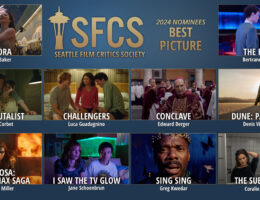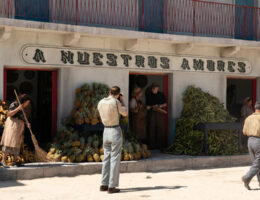Asteroid City (2023 | USA | 104 minutes | Wes Anderson)
In his new film, Asteroid City, Wes Anderson doubles-down on frames within frames storytelling device that he employed in The French Dispatch. Whereas his previous film took inspiration from the quirky pursuits of expat journalists at a New Yorker style magazine, his latest draws from the postwar theater movements, the optimistic paranoia of the Cold War, westward expansion, and the art of making art. Although I found The French Dispatch, deeply moving, it worked better as a series of interlinked episodes. Asteroid City, though, is the full package, a synthesis of both story and the love letter to Anderson’s ideas, influences, and fascinations.
Wes Anderson is among our most stylistically distinctive working filmmakers – from precise framing, impeccably fussy production design, and off-kilter screenwriting – so much so that he’s recently inspired a generation of AI-assisted TikTok impersonators. While the algorithms capture the barebones visual aesthetic, the trend plays into facile misinterpretations of his work as some combination of shallow, twee, upbeat, or ironic. While that’s the polar opposite of my experience, I almost envy those with the worldview or life experience to see (or dismiss) these stories of big little moments so easily. By now, though, viewers who find his oeuvre trite or annoying have certainly seen enough to move along. For the rest of us admirers and devotees, though, great news: Asteroid City is Wes Anderson operating at the peak of his abilities and making a potent argument for his use of intricate artifice as a vessel for deep sincerity.
The film opens in black and white, shot in 4:3 ratio to resemble a 1950s Masterpiece Theatre. A television host played by Bryan Cranston sends our heads spinning with what we’re about to see:
“Asteroid City does not exist. It is an imaginary drama created expressly for this broadcast. The characters are fictional, the text hypothetical, the events an apocryphal fabrication—but together they present an authentic account of the inner-workings of a modern theatrical production.”
We see a playwright on stage typing away at his typewriter (Ed Norton in pajamas, conjuring the spirit of Tennessee Williams). He’s soon surrounded by actors about to do the first read through of this new play, but as the frame widens to reveal a freight train traversing a burnt orange desert beneath infinite blue skies, it’s not clear how much stock we should put in this circuitous and contradictory description of what we’re about to experience.
The action transpires in a desert town (population 87) whose whose luncheonette, service station, and resort of tiny cabins are color-coordinated to echo the cloudless blue sky. A roadside tourist attraction and observatory have been built-up around a crater formed by a meteorite crash thousands of years ago. The desert landscape – constructed as practical sets in the wide open plains of Spain – conjures something like classic Road Runner cartoons and the geography of the final sequences of Close Encounters of the Third Kind. Police car chases and freight trains rush by, cute mushroom clouds occasionally plume in the distance (Oppenheimer isn’t the only nuclear-age mediation of the Summer 2023).
In broad strokes, the play-within-a-play (which is the main action of the film) concerns a gathering of Junior Stargazers, precocious isolated adolescents set to claim sashes, badges, and prize money for their zanily dangerous scientific inventions (jet packs, death rays, long distance image projection, plant growth acceleration). They descend upon the tiny town, populate its resort, and attend ceremonies and demonstrations at the astronomical facility near the crater, and find camaraderie among each other. The festivities culminate in a Celestial Ellipsis (kind of like an eclipse, but cuter) which also coincides with the arrival of a close encounter of the gawky alien kind. It’s awe-inspiring and adorable and it tilts the entire company on its axis.
The setting is ideal milieu for Wes Anderson Things: precocious lonely children of all ages finding connections, flawed fathers and flawed father-in-laws, dead parents, whimsically-rendered bureaucracy, ingenious production design as a both main character and ever-present source of diorama sight gags, pervasive melancholy, and extreme artifice as both stage and shield for big emotional breakthroughs. Chief among the players is Augie Steenbeck (regular Anderson collaborator/muse, Jason Schwartzman), as a war photographer who might have stumbled out Sam Shepard. He’s been procrastinating telling his “brainiac” teen son and his three young daughters (a proto-coven of blonde witchy vampires) that their mother died weeks prior. It’s a treat to see him back in Wes’s spotlight in the role of a wounded adult at a crossroads. He’s counterbalanced by a luminous Scarlett Johansson, as Midge Campbell, glamorous movie star mother of one of the other Stargazers who’s preparing for her next role as an abused housewife. Her presence exerts a tittering magnetism through the town and strange waves of attraction form across their adjacent cabins (their kids have eyes for each other, too).
The rest of the cast is stacked and everyone’s given meaningful business even in brief camera time. Tom Hanks makes his first appearance in the Wes-verse as a stoically grieving father-in-law who comes to the rescue of the son-in-law he never loved and the grandchildren he adores. Tilda Swinton returns as a wistful astronomer who’s envious of camaraderie between the idiosyncratic teens. Steve Carrell is the entrepreneurial manager of the motel and its array of delightful vending machines. Matt Dillon is the town’s deadpan mechanic. Liev Schreiber, Hope Davis, and Stephen Park play the parents of other Junior Stargazers played by Aristou Meehan, Sophia Lillis, and Ethan Josh Lee. Other visitors to the town include Rupert Friend as an insightful traveling cowboy and Maya Hawke as an earnest elementary school teacher steering her eight-year-old pupils on a very strange field trip. Jeffrey Wright is the esteemed military master of ceremonies and Tony Revolori is his trusty aide-de-camp. Jeff Goldblum also makes an appearance, but it’s more fun if you wait until you see it to learn his role.
The family dramas, the arrival of extraterrestrial life, and the heightened emotion in the ensuing chaos is plenty to drive a movie. But Anderson reminds us of the artifice by pulling us back into black & white, cutting away to show us the genesis of “Asteroid City”. We see the playwright in a summer house on Montauk meeting his unlikely star (Schwartzmann again, but in the mode of striving Broadway bit player Jones Hall) and being seduced by his charming commitment to character work. Another cutaway shows the star actress Mercedes Ford (also played by Scarlett Johansson), on a train, having quit the production only to be lured back by an especially effective letter delivered by the intern who would later be cast to play Schwartzmann’s son (an excellent Jake Ryan, grown up since Moonrise Kingdom and Eighth Grade more than holding his own among legends). We meet the play’s director (Adrien Brody, perhaps as a handsomer Elia Kazan), camped in the theater’s prop room for the play’s entire run as a form of escape from his soon-to-be ex-wife (Hong Chau).
These scenes complicate our viewing of the “story” and even challenge our instincts about what “story” we’re meant to care most about. The layers come together, through an alchemy of Goldbergian structure and the gestalt of incredible performances. Anderson’s mode is deadpan reserve, which raises the degree of difficulty in communicating deep emotions to astronomical levels. Seeing what’s going on behind the scenes and informing their performances adds surprising depth and resonance. Schwartzman and Johansson are up to the challenge. We see his “actor” struggling to understand his “character” and fret over whether he’s doing justice to the role. As impressive as his performance is, she’s doing it backwards and in heels: playing an actress who’s playing an Monroe-esque starlet who herself is preparing for another role. It’s turtles all the way down, but it makes it all the more breathtaking when we find ourselves invested in the melancholy longings of “two catastrophically wounded people who don’t express the depths of their pain—because they don’t want to”.
This quiet admission, uttered another across the short distance between their two perfectly-framed cabin windows at sunset, feels like Anderson underlining what’s obvious to some and oblivious to others about his characters. While this scene within the play gets to why his characters are they way they are, another scene – later in the film, earlier in the story – chips away at why he makes movies in his distinctive style. Norton’s playwright pays a visit to an improvisational session conducted by Willem Dafoe (with nods to Lee Strasberg). They’re puzzling through a Method for falling asleep on stage and we see most of the players in the Studio. One makes the noisy realization that “you can’t wake up if you don’t fall asleep!” and soon they’re all chanting along.
Both obvious and nonsensical, it creates a spark of permeability between the film’s many layers and unlocks the motivations for creating abstractions within highly aesthetic abstractions. Rather than undermining the construct of being invested in a play-within-a-film, it magnifies the power of the hall of mirrors as the interlocking stories within reach a series of nested conclusions. Each perfectly placed cactus, hand-built mesa, and artfully designed costume serves a transportive purpose. These adoringly constructed settings enhance the quiet power of meaningful silent shared glances across a luncheonette counter as well as the collective awe of an assembly of star watchers as the night sky glows green with the arrival of something altogether new. All of these complex and intricate layers provide a way to get at the depths of feeling that the characters would rather not express directly, but it’s hardly as cerebral as it sounds. There’s even a little kid singing a Jarvis Cocker song and a stop-motion road runner! Having only seen it once, I’m confident that I missed every nuance of the structure. I nevertheless look forward repeat viewings as well as the ornate fan-created diagrams that are almost sure to follow. Regardless, you don’t need a detailed blueprint to appreciate the supremely moving sentiment that echoes throughout. Book at ticket to Asteroid City and ride it all the way to the moon, it’s upper echelon Wes Anderson.
Asteroid City opens June 23rd in Seattle.
Images courtesy Focus Features




